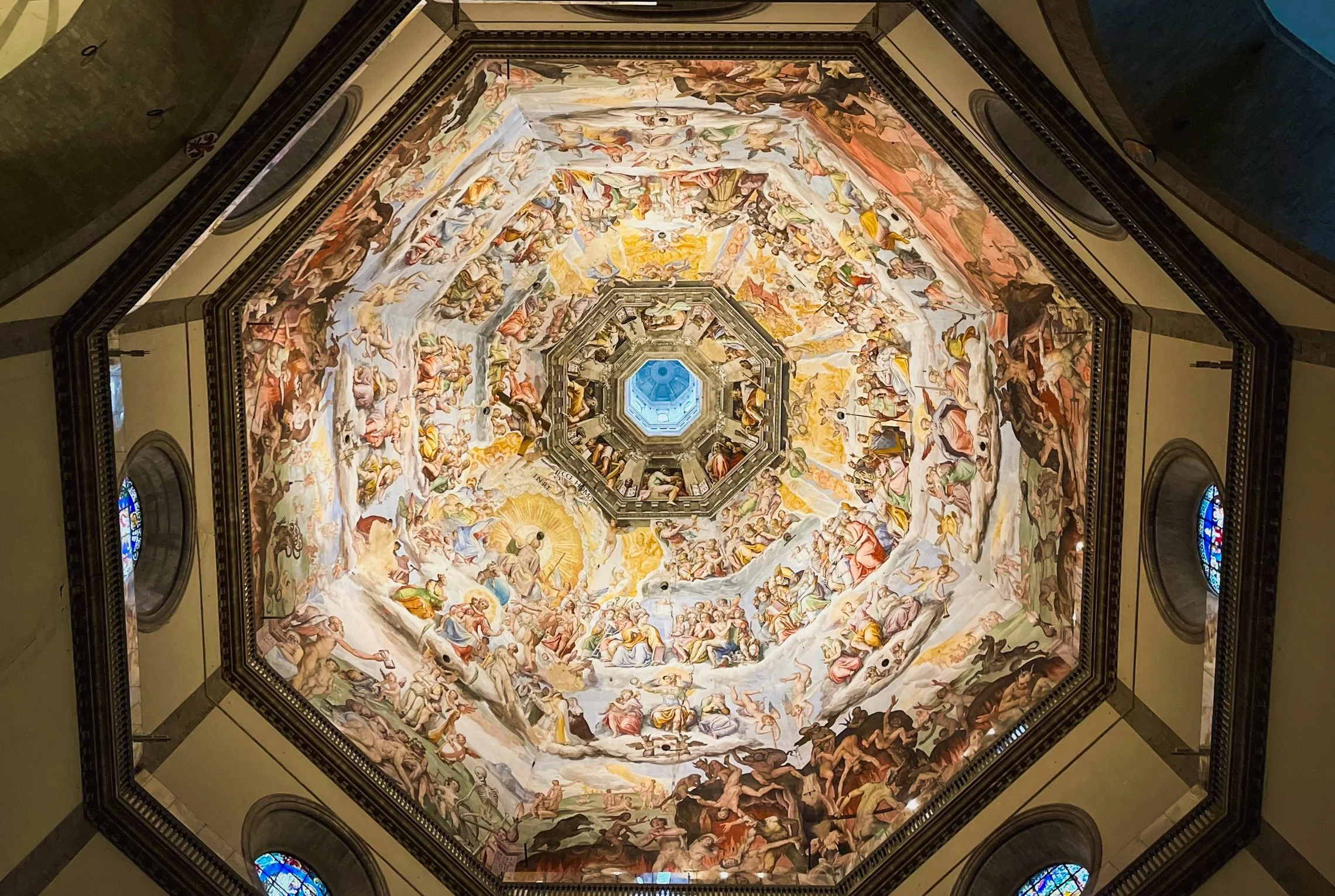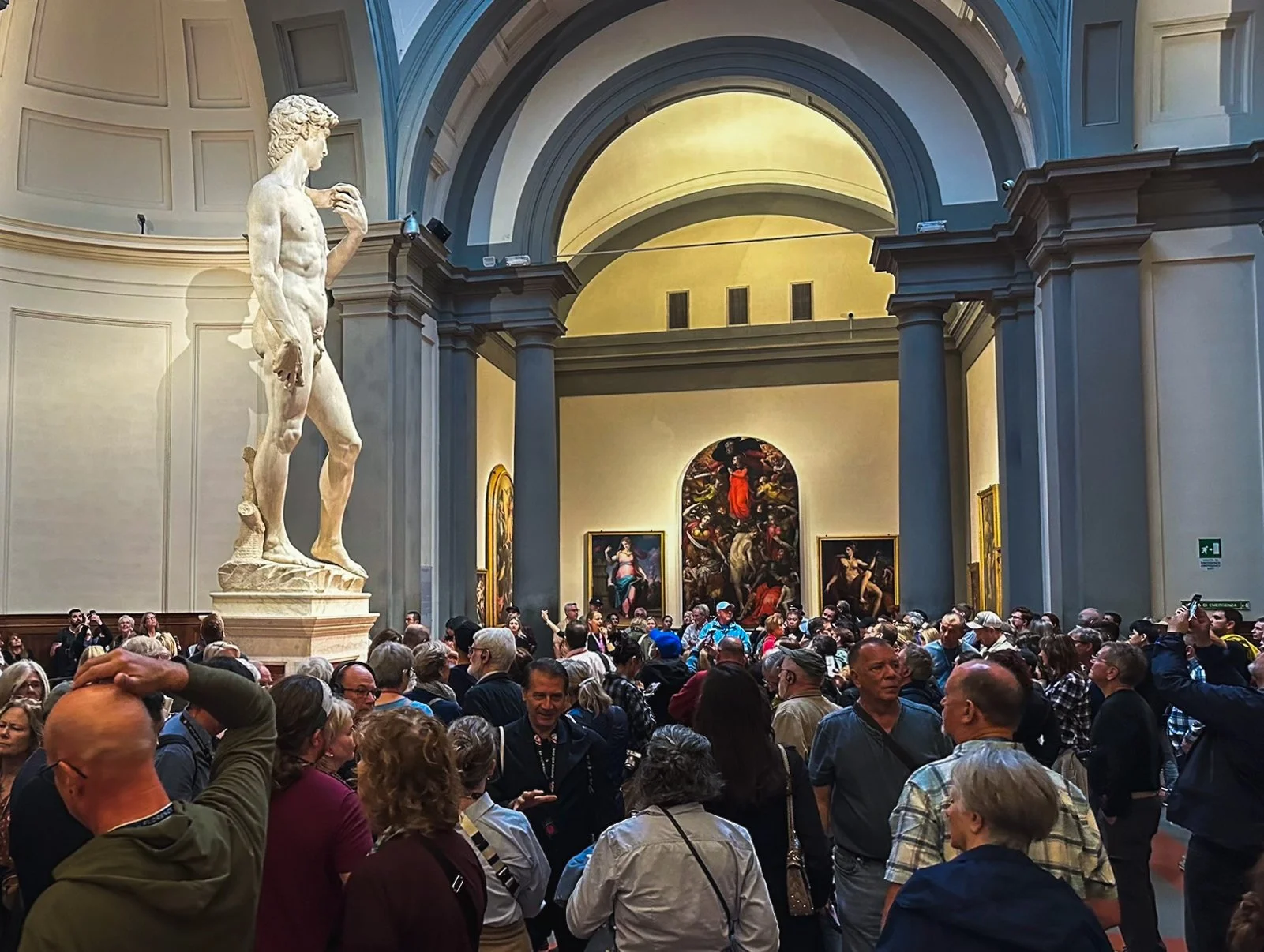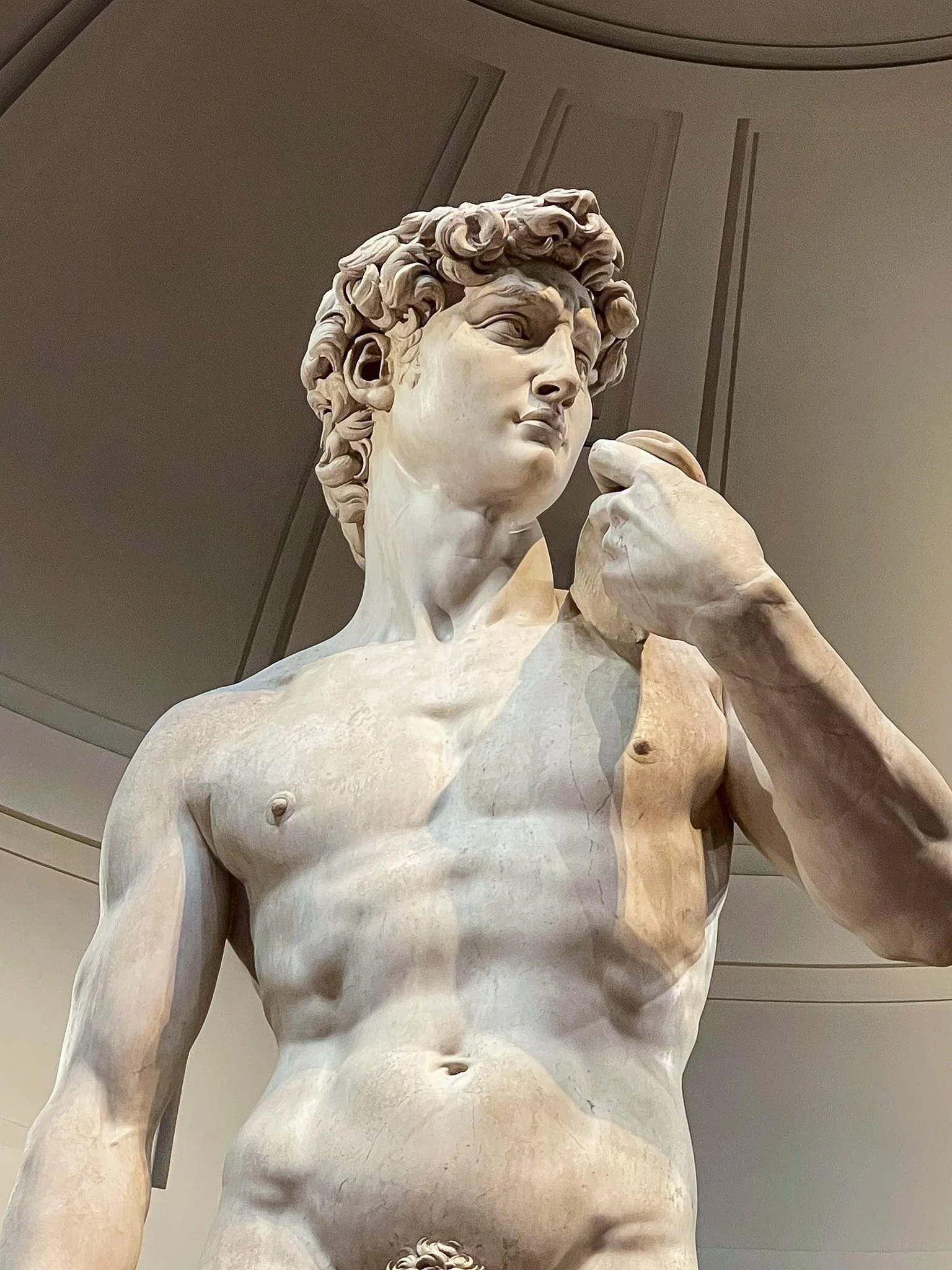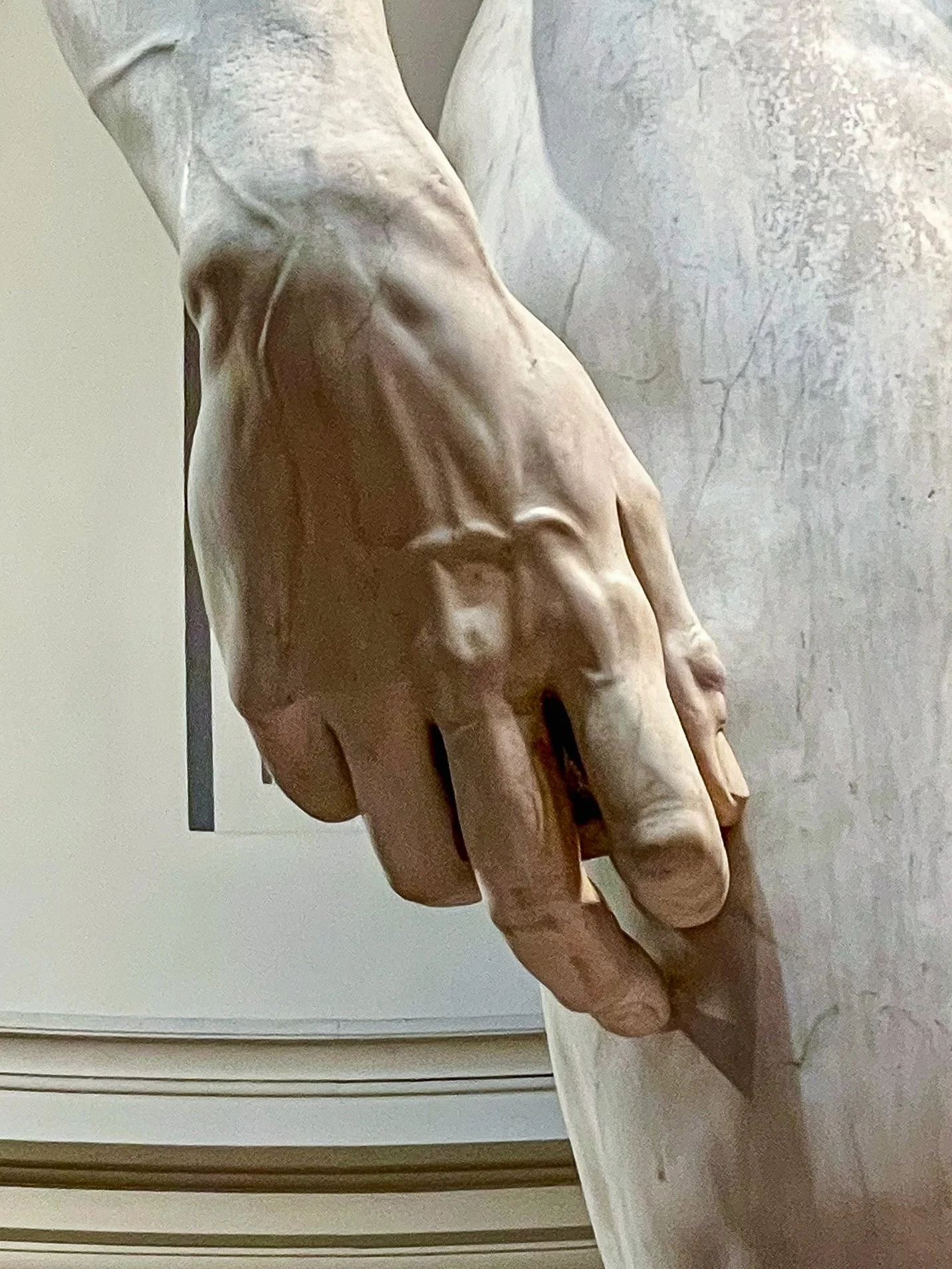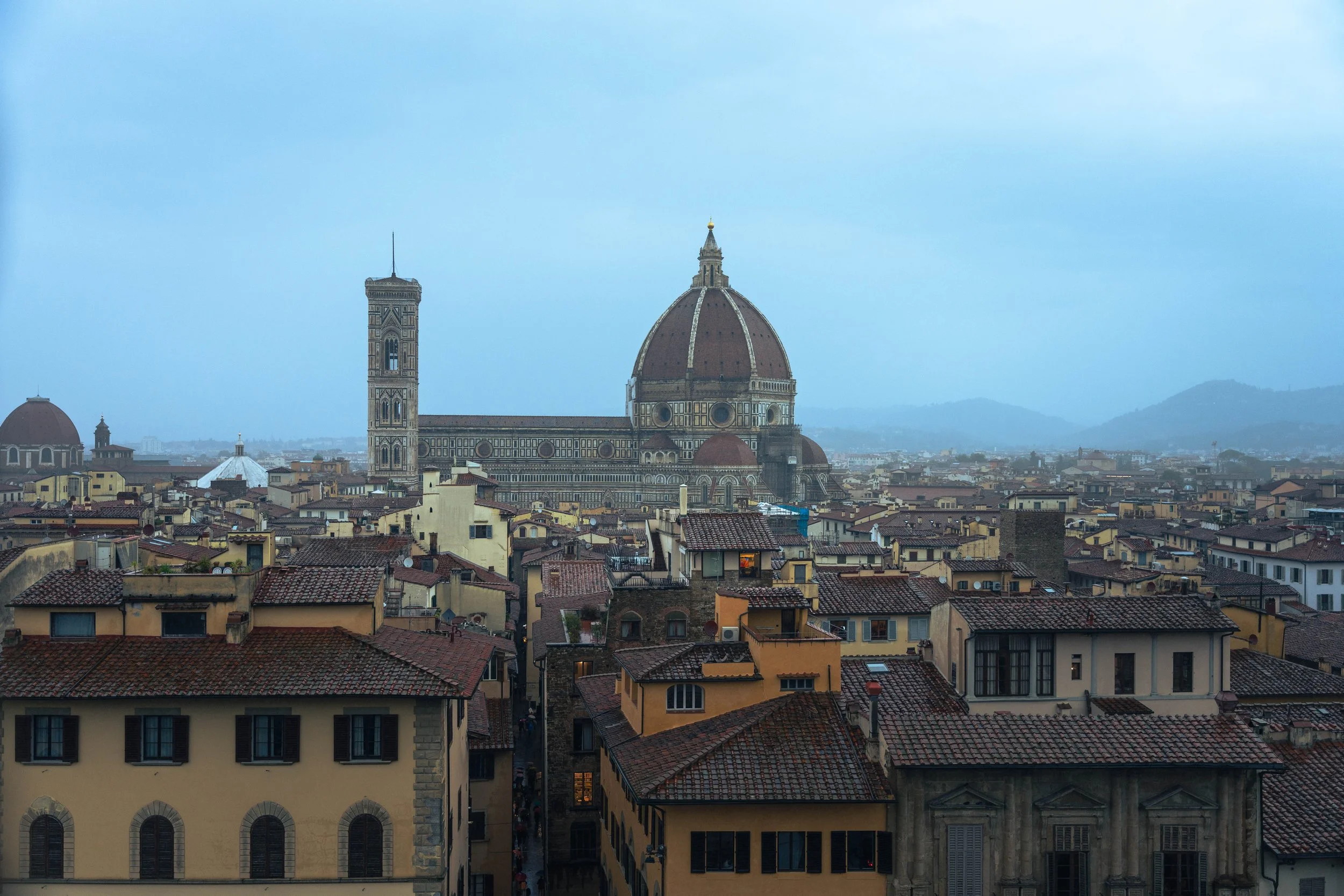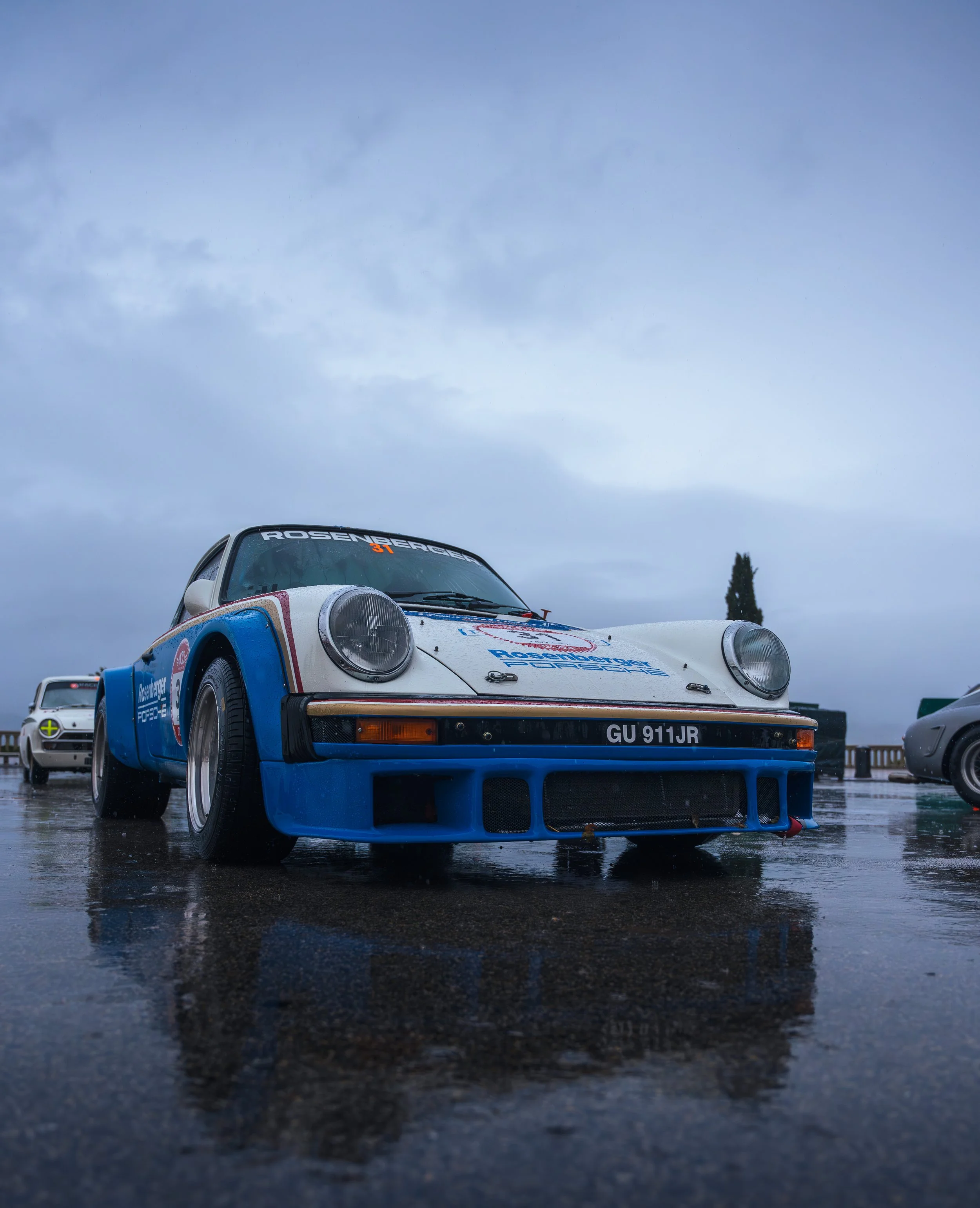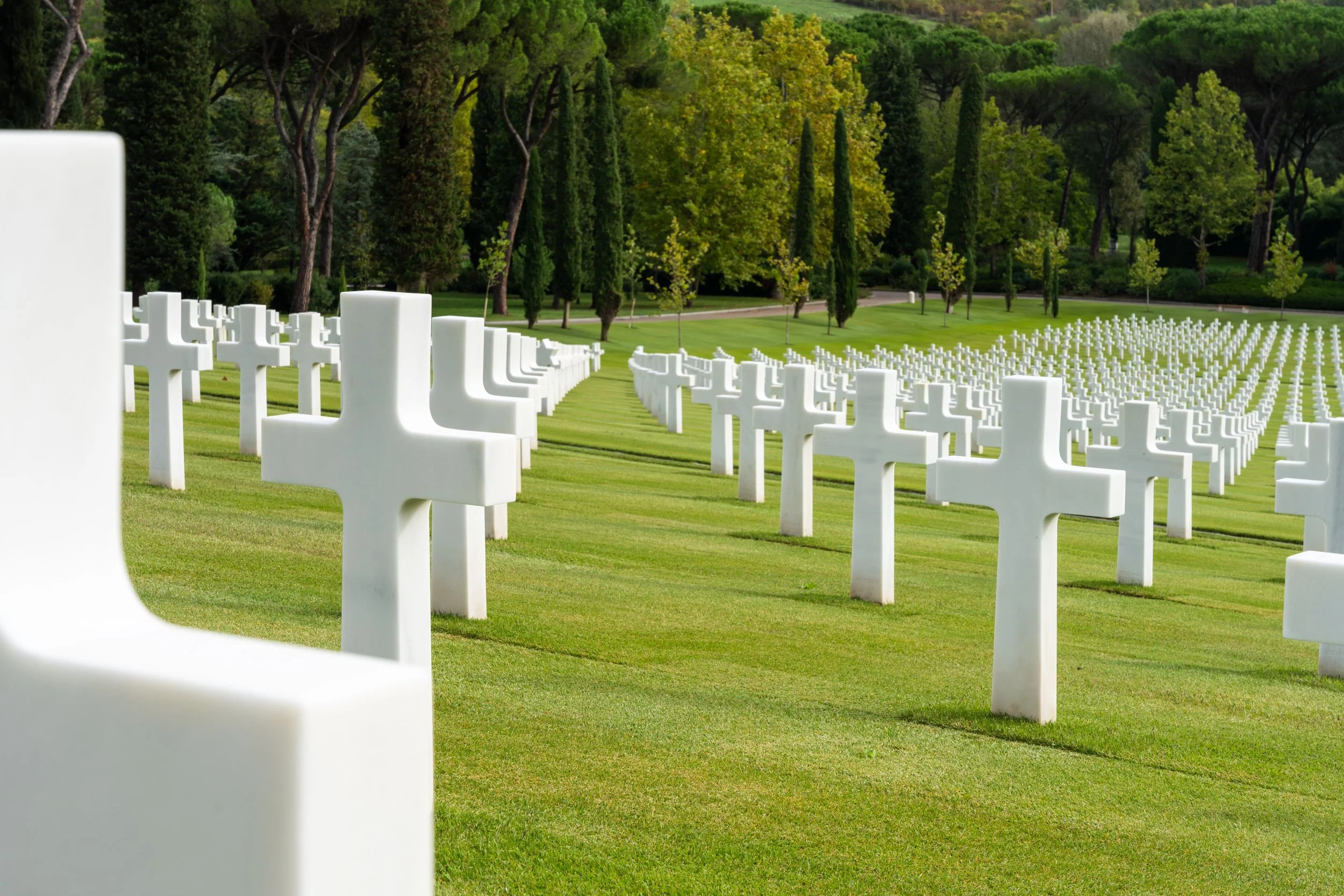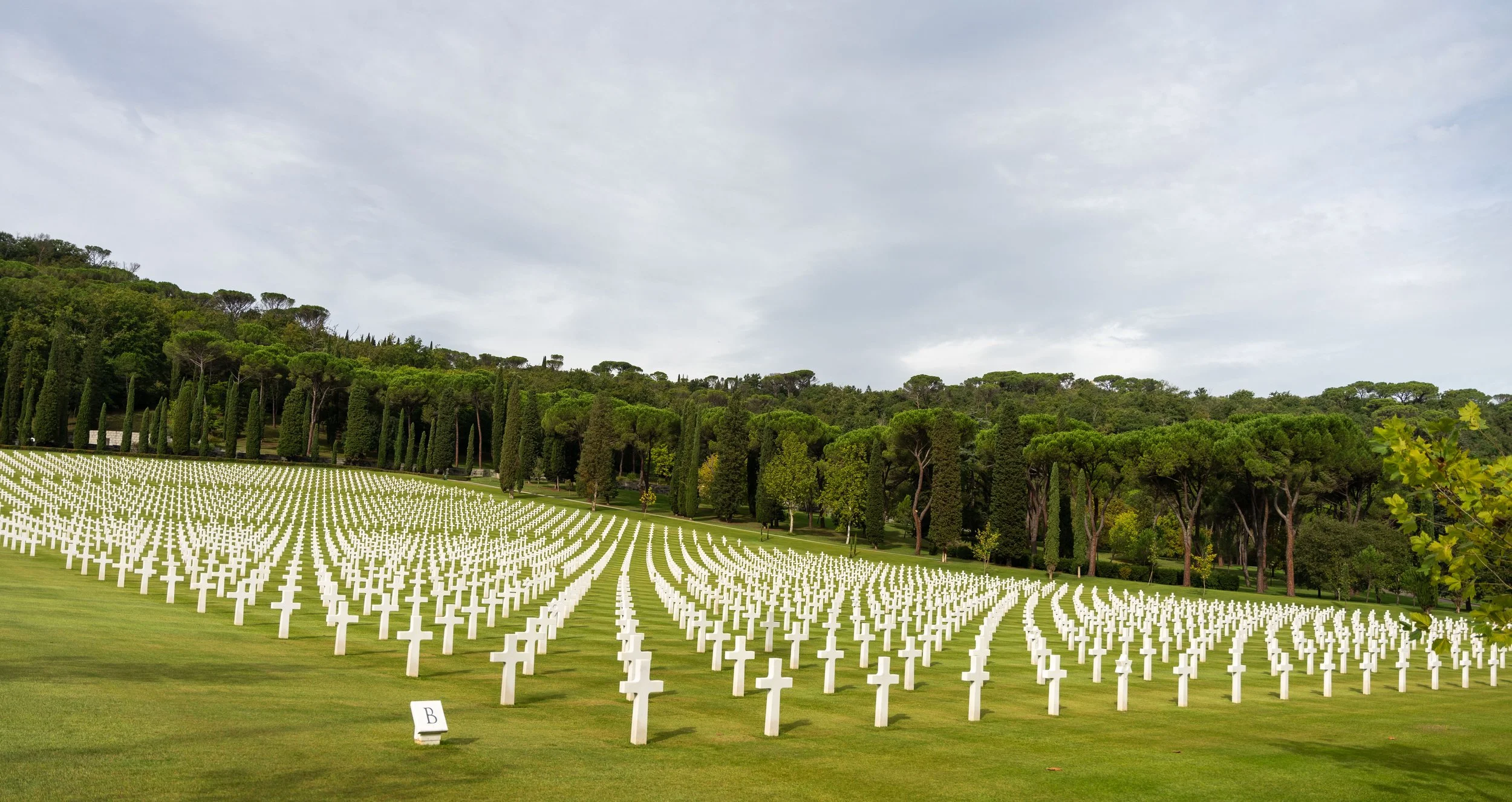My Way Italy Day 7-8: Meeting David in Florence
My Way Italy Day 7: Arriving in Florence
After bidding farewell to the rugged charm of Cinque Terre, we headed inland to Florence, the birthplace of the Renaissance — the cultural movement that reshaped Europe in the 14th century. Today, Florence is a global symbol of art, history, and architectural grandeur, where every corner feels like an open-air museum. For us, it was a pilgrimage to witness the works of Michelangelo and other masters, names so iconic they’re etched into the DNA of Western art.
Florence’s skyline is a symphony, but its centerpiece is the Duomo, a masterpiece of Italian Renaissance architecture. When completed in the 15th Century it was the largest cathedral in the world. It was also the first dome to be built in over 1,000 years.
Seeing it for the first time was overwhelming — its sheer scale and intricate details are mesmerizing. The green, pink, and white marble facade, painstakingly preserved for nearly 600 years, seems alive with the energy of the artisans who keep it radiant. And while its exterior astonishes, nothing prepared me for the grandeur of the interior, a sanctuary of spiritual and artistic transcendence. Florence doesn’t just invite you to see the Renaissance — it demands you feel it.
Overview
-
Duomo: The Cathedral of Santa Maria del Fiore, is a stunning blend of Gothic and Renaissance architecture. Its distinctive marble façades, along with the panoramic views from the dome’s summit, make it an iconic symbol of the city.
Galleria dell’Accademia: Best known for housing Michelangelo’s “David,” along with other notable sculptures and Renaissance artworks. It offers insight into the city’s artistic heritage and preserves key pieces from the 13th to 16th centuries.
Palazzo Vecchio: A historic fortress-palace that has served as the city’s town hall since the Middle Ages. Its medieval architecture and richly decorated rooms reflect Florence’s political power and artistic heritage.
Piazzale Michelangelo: an iconic square offering sweeping panoramic views of the city's historic skyline, including the Duomo and Palazzo Vecchio. It's a favorite spot for locals and tourists to appreciate the beauty of Florence (rain or shine).
Florence American Cemetery: A World War II cemetery near Florence that honors fallen American soldiers. Its serene grounds and engraved headstones serve as a lasting tribute to their sacrifice.
-
Mercato Centrale: This vibrant indoor market is known for its fresh local produce, traditional Tuscan specialties, and artisanal delights—all reflecting the city's rich culinary culture.
L' Antica Cantina del Chianti: A rustic trattoria known for serving authentic Tuscan dishes paired with an extensive selection of local Chianti wines. Its warm, inviting atmosphere reflects the rich culinary heritage of the region.
Eatley: A contemporary dining spot that offers modern Italian cuisine with a creative twist on traditional flavors. It’s also a great place to warm up from the rain.
La Loggia del Piazzale Michelangelo: Located at at the iconic Piazzale Michelangelo that offers sweeping views of Florence. Its covered seating makes it an ideal place to enjoy a cold beer on a rainy day while enjoying the breathtaking panorama.Osteria Giglio d’Oro: Serves authentic Tuscan cuisine made with locally sourced ingredients only a few blocks from the Duomo. It offers an intimate dining experience that captures the essence of Florentine culinary tradition.
-
If you’re visiting Florence on a rainy day like we did be sure to have a decent pair of shoes that will keep your feet dry, your umbrella and a good rain jacket ready.
Also consider exploring Florence’s rich indoor attractions like museums and historic churches, and warm up with a cozy coffee in one of its charming cafés.
Visiting The top of Florence: the Duomo
Walking into the Duomo was like stepping into another dimension. The sheer scale of the interior, with its soaring ceilings and masterful artwork, draws you deeper into its sacred space. At its heart lies The Last Judgement, an incredible fresco by Renaissance masters Giorgio Vasari and Federico Zuccari. Words fail to capture the impact of seeing it in person — the intricate depiction of the eternal battle between heaven and hell is staggering. Every figure, every flourish, seems alive with purpose, pulling your gaze into a scene that feels as eternal as its subject. I could have spent hours exploring the layers of detail, each revealing its creators' extraordinary dedication.
As I stood there, lost in the painting, I was struck by how much it speaks to artists across time. Whether it’s a Renaissance fresco or a modern motion picture, the message is clear: attention to detail and craftsmanship elevate a work to greatness. The tools may change, but the commitment to creating something meaningful remains the same.
After marveling at the interior of the Duomo, we embarked on the 376-foot climb to the top of Brunelleschi’s dome. The 463 steps spiral relentlessly upward, winding through passageways that feel more like the veins of an ancient giant than a tourist trail. It’s narrow, steep, and unforgiving, but every step carries the weight of history.
Halfway up, the climb reveals a masterpiece: The Last Judgement, a fresco depicting the eternal struggle between heaven and hell. Seeing it up close is staggering. From this vantage, the intricate brushstrokes, vibrant colors, and dramatic figures leap off the surface. The sheer detail — angels and demons locked in cosmic battle — is enough to stop you in your tracks. It’s a front-row seat to Renaissance genius.
But the ultimate reward is at the top. A 360-degree panorama of Florence unfolds, with red-tiled roofs stretching endlessly in every direction. To the north, the rolling hills dotted with cypress trees and olive groves beckon. To the south, the Arno River snakes through the city, cutting a graceful path past the Ponte Vecchio.
What’s most profound, though, is the realization of what this dome represents. Brunelleschi’s daring innovation didn’t just transform Florence’s skyline; it redefined what humans could create. Standing at the top, you don’t just see Florence — you feel its spirit. It’s not just a city; it’s a living, breathing canvas that has inspired centuries of dreamers, artists, and visionaries.
After twenty awe-struck minutes at the top, we descended back to the ground, still trying to process the sheer scale and presence of the Duomo. It’s impossible to overstate its impact — this is more than a building; it feels like the beating heart of Florence, with the city radiating outwards like a living organism. Everywhere I looked, people were drawn to it, just as I was, compelled to get closer, to touch the soul of this architectural marvel.
The rest of the afternoon, I circled the Duomo, camera in hand, trying to capture its grandeur from every possible angle. But no matter how many shots I took, it became clear: this isn’t something you can fully grasp through a lens. Architecture, like all great art, carries the weight of its era, and the Duomo is no exception. Yet, it transcends its time, standing as a testament to human ingenuity and the Renaissance spirit of creativity. It’s not just something to see — it’s something to experience. Words fall short. To understand its true impact, you have to stand in its shadow, let it overwhelm you, and feel the pulse of Florence through its walls.
The art of perfect ravioli
That evening, we joined another cooking class, this time with a lively group of Americans from the East Coast. It was yet another reminder of why Italian food is the ultimate comfort cuisine — simple, honest, and perfected over centuries. On this night, we made ravioli and linguine with marinara, dishes so classic they’re practically in Italy’s DNA. What struck me was how something so magical could come from such humble ingredients: flour, water, eggs. As I kneaded the dough, there were moments of doubt — was it too sticky? Too dry? — but in true Italian fashion, everything came together beautifully when it hit the plate.
Sitting down to enjoy the fruits of our labor, paired with a glass of local wine, felt like the very definition of La Dolce Vita — or, in our case, Lutz Dolce Vita. The food wasn’t just good; it was a celebration of life itself. Even better was the chance to connect with our classmates, swapping stories about their adventures in Florence and where their Italian journeys would take them next. It was a night of great food, great company, and the kind of moments that make you feel like you’ve truly tasted Italy.
Taylor Tip
To save space in your luggage there is no need to pack an umbrella. Instead, you can buy one while on your trip if needed for only a few euros.
My Way Italy Day 8: Meeting David and Exploring Florence
After a quick breakfast, we rushed out of the hotel, hearts racing with anticipation, to meet the most famous man in Florence. Just a block and a half away stood the Galleria dell’Accademia, the home of Michelangelo’s David since 1873. Each year, nearly 1.5 million people make the pilgrimage to see this masterpiece, and as soon as I stepped inside, it was clear why.
I expected David to be part of a larger exhibition, but instead, he commands the room. Towering at an astonishing 17 feet and weighing 6 tons, this marble giant is impossible to ignore. The moment you see him, your eyes are drawn to every detail — the veins in his hands, the tension in his muscles, the resolute gaze. Even 521 years later, Michelangelo’s perfection of the human form feels alive, a testament to his genius.
I spent what felt like ages circling the statue, viewing it from every angle, awed by its timeless presence. What stunned me most was the story behind it: Michelangelo, at just 26 years old, took a discarded block of marble, dismissed by others as flawed, and transformed it into one of the most iconic sculptures in history. Standing before David, I couldn’t help but feel both inspired and humbled. Michelangelo saw potential where others saw failure, and in doing so, he created something that will outlive us all.
“When you look at David, you’re looking at Renaissance man.”
After bidding farewell to David, we stepped into rainy Florence, our path leading us to the Palazzo Vecchio, a towering sentinel over the lively Piazza della Signoria, once the original home of Michelangelo’s masterpiece. This imposing fortress-palace, with its medieval grandeur, served as Florence’s town hall, its grand halls capable of holding nearly 500 people, a testament to the city’s ambition and power. Today, the Palazzo Vecchio is a museum, inviting visitors to explore its history, art, and hidden passages. From the heights of its Arnolfo Tower, the Florence skyline unfolds in all its splendor, with the Duomo rising like a crown over the city.
Even under the gray veil of rain, there was a quiet magic in the air. The Duomo loomed in the distance, its timeless presence amplified by the rhythmic tolling of the church bells, a sound that seemed to carry the soul of the city through the damp streets. Florence felt alive, its history and spirit woven into every echo.
Florence Street Musicians
Wandering the streets of Florence, I stumbled upon an unexpected delight—local musicians filling the air with their melodies, their notes weaving through the narrow alleys and ricocheting off the ancient stone walls. The sound transformed the city, creating an atmosphere unlike anything else I’d experienced on this trip. The music felt like a breeze stirring the soul, light and effortless, yet impossible to ignore. Crowds gathered, drawn in by the rhythm and energy, adding a unique vibrancy to an already enchanting place.
The real surprise came when I learned one of these musicians was something of a Florentine legend. A quick Instagram search revealed countless posts featuring an elderly man with his accordion, a fixture of the city’s streets, bringing joy to locals and travelers alike. His music wasn’t just entertainment—it was a thread in the fabric of Florence, stitching together moments for anyone who stopped to listen.
Reflecting on this, I realized that artistry and creativity aren’t bound by age. Watching this man share his gift made me aspire to do the same in my life—continuing to create, inspire, and connect, no matter the stage of life. In Florence, even the simplest moments, like an accordion’s melody dancing through the streets, feel timeless.
Rainy View of Florence
The rain began as a drizzle but quickly escalated into a relentless downpour. People scattered for cover, and we ducked into a cozy trattoria for lunch, hoping the storm would pass. Recharged by an incredible meal and seeing a break in the weather, Taylor and I decided to roll the dice and bike to Piazzale Michelangelo, Florence’s iconic hilltop viewpoint.
But as we crossed the Arno River, the rain returned with a vengeance. The climb became an absurd adventure, with Taylor balancing his bike one-handed while wrestling an umbrella. When we reached the top, we were greeted by a vintage car rally, with classic Porsches, Jaguars, and Ferraris gleaming against stormy skies. For a motorsports fan and car enthusiast, it was a dream, and I alternated between admiring the cars and capturing their elegance through my lens.
The view was equally breathtaking: sunshine broke through clouds over the Tuscan hills, while stormy skies lingered over Florence. The contrast was stunning, embodying the city’s dramatic spirit. We capped off the experience with beers under the La Loggia del Piazzale Michelangelo, soaked but exhilarated, reveling in the chaos and beauty of the day.
Even under relentless rain, Florence dazzled. This city, the birthplace of the Renaissance, felt like a living monument to the creativity that has shaped Western culture. Standing beneath the Duomo, I marveled at the architectural ingenuity that made its construction possible. Meeting David was equally humbling—a discarded block of flawed marble transformed into one of humanity’s greatest artistic triumphs.
What struck me most was the enduring ingenuity of the people who built this city. In just two days, Florence reminded me of the power of human imagination to reshape the world. The Duomo and David felt like messages in a bottle, sent across centuries, whispering, "We’re still here." Through their work, the Renaissance masters seemed to remind us that what we create today can transcend time and alter perspectives for generations. As we departed for Assisi, I couldn’t shake the feeling that Florence still had more to say—a dialogue I wasn’t quite ready to leave behind.
Taylor Tip
To see more of a city, be sure to consider other forms of transportation like scooters and e-bikes. This will allow you to go further and see more. If you opt for two-wheels be sure to follow local traffic laws.
Day 9: Leaving Florence & Remembering the Fallen
On our way out of the city, an unexpected stop brought us to the Florence American Cemetery, just half an hour outside Florence. It felt surreal to stumble upon this peaceful resting place in northern Italy, dedicated to the thousands of American service members who gave their lives during World War II to secure the freedoms we often take for granted.
Surrounded by a sea of white crosses and stars of David, I felt the weight of history. These weren’t just names etched in stone; they were people—young, determined, and far from home—who answered a call bigger than themselves. As I looked out across the sprawling graves, the reality of their sacrifice was inescapable, a profound reminder of the immense cost of freedom.
After a brief history lesson on the sacrifices American service members made for our freedom, we were each handed a small flag—a simple gesture, yet profoundly humbling. We placed them at the graves of those who had given everything, a quiet tribute against the backdrop of endless white crosses. The flag itself was small, but it couldn’t begin to measure the weight of respect and gratitude I felt for those resting in this hallowed ground.
Name: Lloyd Douglas Farnell
Rank: Private 1st Class
Service Number: 3920309
Service: 91st Quartermaster Company, 91st Infantry Division, US Army
Date of Birth: May 31, 1922
Place of Birth: Middle Musquodoboit, NS
Date of Enlistment: March 4, 1943
Place of Enlistment: Seattle, Washington
Address at Enlistment: Pierce, Washington
Age at Enlistment: 20
Height: 6 feet, 1 inch
Complexion: Light
Hair: Brown
Eyes: Gray
Trade: Checker
Marital Status: Single
Next of Kin: Norman Farnell (Father)
Date of Death: June 3, 1945
Age: 23
Cemetery: Florence American Cemetery, Italy
Grave Reference: Plot F, Row 9, Grave 10
From wartimeheritage.com:
Douglas Farnell was the son of Norman Parker Farnell (1887-1970) and Janet Melinda (Densmore) Farnell (1898-1994). His father was born in Musquodoboit, NS; his mother – in Brookfield, Colchester Co., NS. Lloyd had one sister, Gladys May (Farnell) Sprouffske (1923–2018).
Lloyd’s father Norman served Canada in the First World War with the 85th and 13th Battalion, Canadian Expeditionary Forces (Service No. 222664). He served in Canada, England, and France. His uncles Ruffus William Farnell, and Allison Hood Farnell, also served in WWI.
The family moved to the US in the 1920’s (December 9, 1922, on CP Railway #19 from Shubenacadie, NS to Detroit Michigan, and settled in Washington State. His sister Gladys was born a year later in 1923. Throughout the 1930’s and 1940s, the family lived on McKenna Street, in Pierce, Washington. Lloyd completed his declaration of intention to become a US citizen on September 25, 1941, in Tacoma, Washington. He registered for the US Draft on June 30, 1942, in Washington, was working for the Eatonville Lumber Co. at the time, and enlisted to serve in the US Army less than a year later in March of 1943.
The 3rd Infantry Division departed for the European Continent on April 3, 1944, and served in Italy. PFC Farnell died on June 3, 1945. His death was non-battle related while serving in Italy. Private 1st Class Lloyd Douglas Farnell was interred at the Mirandola Cemetery, in Mirandola, Italy (Temporary cemetery 5252) in Plot J, Row 3, Grave 1185, and re-interred with grave consolidation at the Florence American Cemetery.
The Florence American Cemetery is just outside of Florence, Italy, framed by the hills of Tuscany. Nearly 4400 are buried there. Most died in the hard-fought campaigns against Nazi Germany in Northern Italy in the war’s final year. The statue of an American 91st Division soldier stands watch over his fallen comrades as the Tuscan sun rises and falls over the cemetery.




